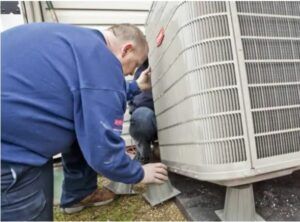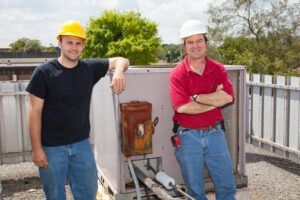Maybe you should become a HVAC tech.
After all, they’re in high demand—according to the Bureau of Labor Statistics, HVAC technician employment is expected to rise by 15 percent through 2026, much higher than the average occupation—particularly now that we’re coming out of the pandemic and everybody is so concerned with the purity of the air we breathe.
Interested? Read on.
In this post, we’ll look at what it takes to become an HVAC tech, what training is involved, and how much an HVAC tech earns. When you finish the article, you’ll have a good idea if this is something you want to pursue.
What does an HVAC tech do?

HVAC technicians install and repair HVACR systems, which stands for Heating, Ventilation, Air Conditioning, and Refrigeration. The HVACR system provides heating and cooling to residential and commercial buildings, along with refrigeration for preserving food and refrigeration and heating needed in production applications. You can find HVACR systems anywhere from single-family homes and commercial applications to submarines—anywhere people want comfortable surroundings.
Some of the specific responsibilities of an HVAC technician include:
- Use various tools—such as metal cutters, current meters, and flow sensors—to repair HVACR systems.
- Ensure that all components of the system (motors, pumps, fans, compressors, switches, thermostats, etc.) are working properly.
- Connect wires.
- Test electrical circuits.
- Weld pipes.
- Test tubing and pipes for leaks.
Pretty much, HVAC techs will dip their toes into other trades on a day-to-day basis. “That’s what I liked about it,” said Brian Moore, HVACR and building automation instructor and HVAC department director at Madison College in Madison, Wisconsin. “I know a little bit about the things the other tradespeople have to be experts at. For example, we basically have to learn about fluid flow through piping; the basics of plumbing; the proper way to put PVC, iron, or copper piping together using welding, brazing and soldering methods.
“In terms of electrical, we can’t bring power from the power pole to the breaker panel, but we have to fully understand electrical circuits and how to bring power from the breaker panel to our devices, how conduit is bent, and how to move these wiring systems—point A to point B. We’re always troubleshooting electrical circuits.
“In terms of mechanical, we repair and put together mechanical systems all the time—for example, hanging air handlers from trusses, installing boiler and refrigeration systems with multiple independent pieces of equipment all working together.”
There are many different aspects of HVACR that technicians can specialize in. “For example, there’s a tin guy who specializes in building ductwork. Fabricating tin,” Brian said. “There’s pipe fitters, welding pipe together, making piping systems. Troubleshooters. Installers.
Maintenance people. HVAC control technicians.”
Some technicians become much more specialized in the types of work they take on as their careers progress. For instance, an HVAC installer may work for contractors who build new homes or buildings and therefore specializes only in installations of new systems rather than repairs. Some HVACR techs also go on to specialize in air conditioning or refrigeration, steering away from heating and ventilation.
“Some of the best advice I got was never stop learning,” Brian said. “In this industry, we cannot be stagnant. So any time your employer says, ‘We’d like to send you to ice machine class or boiler class,’ go to it. Learn how to fix ’em. The more you know, the more you’re worth in this industry.”
What training is required to become an HVAC tech?

Most people interested in a career as an HVAC technician begin by taking courses at a technical school or community college. Shorter programs may last only six months and result in an HVAC technician certificate, while longer programs can last up to two years and result in an associate degree. People can also go through a four- to five-year union or nonunion apprenticeship program that will combine work in the field with classroom study.
That was Brian’s path, earning an associate degree at Chippawa Valley Technical College. Then, after he was hired by North American Mechanical (now Comfort Systems), he started an apprenticeship sponsored by the employer. He never finished the apprenticeship because of professional growth and work demands, and after 9/11, he went on active duty with the National Guard. When he returned to civilian life, it wasn’t too long before he started instructing.
At Milwaukee Area Technical College, where Instructional Chair Deb Richards has been an instructor for the past 23 years, they offer two programs: a diploma program and a two-year associate degree. Demand is so high for people with the right skills, she said, that industry partners come to pluck her students from, say, the associate program after only one year. She tries to get them to see that’s shortsighted.
“Knowledge is king,” said Deb, a journeyman steamfitter of 35 years. “Do you want a person with limited book knowledge doing brain surgery on you, or do you want the person who’s gone through all the practical training and hands-on and residencies? HVACR is the heart of a building. If you don’t understand that heart, you’re going to make a mistake.”
How much do HVAC techs earn?

According to the Bureau of Labor Statistics, the average salary of an HVAC tech is $45,910. After three years as an HVAC tech, Brett Viers of Quality Heating and Cooling in Livonia, Michigan, earns upward of $60,000, and he has his eyes on a higher ceiling than that. That’s why he’ll be going out on his own soon with his own company, MI Choice Heating and Cooling LLC.
“I work 9 to 5 for Quality during the day and then after 5 until I drop and on weekends for myself. I was real upfront when I started with Quality what my plan was. They’d like me to stay, but in five years, I want to be the guy behind the desk telling his crews where to go,” he said. “We want it so my wife doesn’t have to work outside the home and can take care of our kid. “
Deb from Milwaukee Area Technical College said, “One of our diploma-level students can start out making $35,000 to $40,000. If they go through the two-year associate program, they’re starting at $45,000 to $65,000.” From there, she said, the more experience you get and the more you learn: “The sky’s the limit.”
“If you get competent in refrigeration, for example, you’re talking $75,000 to $100,000 easy,” she said as an example.
What separates the great HVAC techs from the good HVAC techs?

“The best HVAC techs don’t rush,” said Brett. “Too many guys are quick to pull the trigger. They hear something and they assume they know what the problem is. Just take the extra three minutes to take out your meter. You can be wrong, but your meter is never wrong. In the end, you solve the problem more quickly. The customer’s like, ‘You were here only 10 minutes and you figured it out! You’re the fourth guy who has looked at it!’”
Here’s how Deb summed it up:
“Reliable. Responsive. Able to work independently. Being able to take your base knowledge and troubleshoot. See a problem, conquer the problem. I need a person who can be at the job site on time and have good customer service skills—because if the customer has called for service, they’re already upset. They need their problem resolved. If a person is a hothead or doesn’t relate well to people, that’s going to be a problem. So honesty, integrity, self-motivation. Someone who wants to learn something every day. The trade is changing at such a rapid rate, so constant learning is
Did you like this post? You may also like:
Everything you need to know about becoming a plumber
Everything you need to know about becoming an electrician
Everything you need to know about becoming a welder
Everything you need to know about becoming a carpenter
Everything you need to know about becoming a roofer
Everything you need to know about becoming a mason
Everything you need to know about becoming a painter
Was this blog post helpful for you? Why not subscribe to our blog? It’s free. Just input your email address below. We promise we won’t spam you. However, as our way of saying thanks for subscribing, we’ll send you our e-book, “4 Things to Consider When You’re Looking for a Temporary Staffing Firm.”
Subscribe








